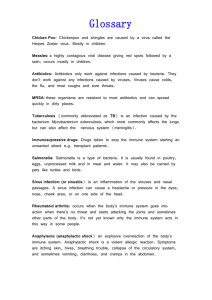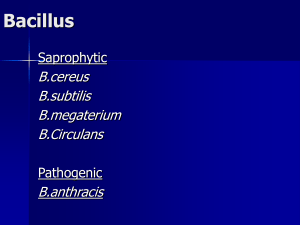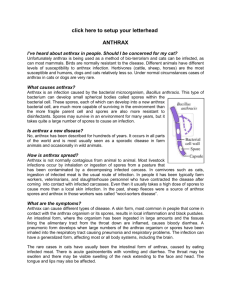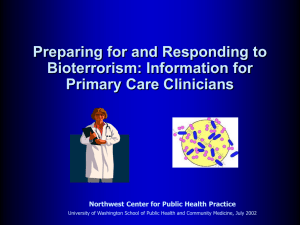Vanya
advertisement
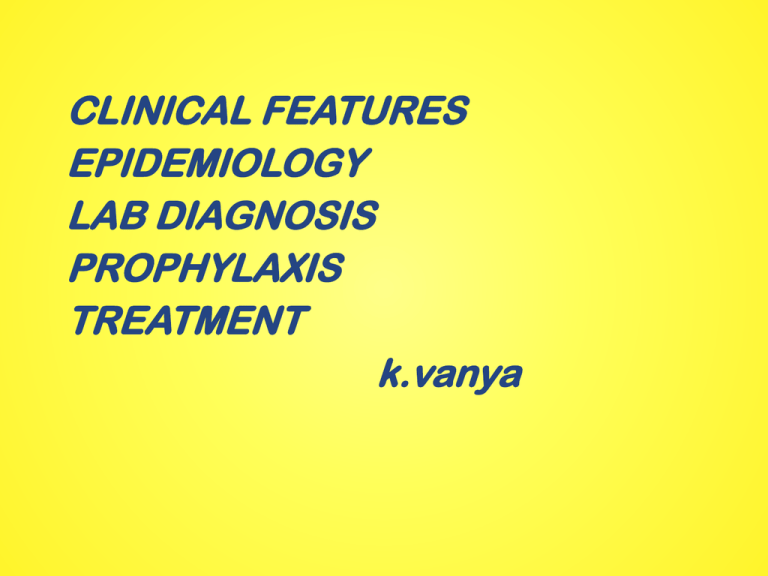
CLINICAL FEATURES EPIDEMIOLOGY LAB DIAGNOSIS PROPHYLAXIS TREATMENT k.vanya Clinical features Clinical features of B.anthracis: Anthrax is a zoonotic disease. Anthrax “coal” ,comes from black colour of eschar Route of infection: ingestion / inhalation of spores /it may enter directly through skin. Infective material: discharges from mouth , nose &rectum of infected animals. The large no. of bacilli present in those discharges sporulate in soil and remain as source of infection. Direct spread from animal to animal is rare. it causes fatal septicemia, but some times it is localized/resemble cutaneous diseases in humans. acquired from animals directly / indirectly. Based on clinical features, Anthrax is divided into 3 types cutaneous pulmonary intestinal All these lead to fatal septicemia/meningitis Cutaneous anthrax Also called “hide porter’s disease”, as it is common in dock workers, Route of infection: infection enter through abraded skin. ◦ Also by shaving brushes made of animal hair Usual sites: face,neck,hands,arms&back Lesion starts as papule 1-3 days after infection becomes vesicular (fluid clear/blood stained) Malignant pustule: The whole area congested, edematous & several satellite lesions filled with yellow fluid/serum arranged around central necrotic lesion which is covered by black eschar. resolves spontaneously. Complications: 10-20% develop fatal septicemia/meningitis Malignant pustule Congested Edematous Satellite lesions Pulmonary anthrax Also called “wool sorter’s disease”. Because it is common in wool factories. Route of infection: due to inhalation of dust from infected wool. More severe than others. Complications: hemorrhagic pneumonia (common) hemorrhagic meningitis(rare) Intestinal anthrax Rare Mainly in primitive communities i.e. who eat dead bodies of animals died of anthrax. Complication: violent enteritis with bloody diarrhea with high fatality rate Based on occupation industrial non-industrial Industrial: such as meat packing/wool factories. Non-industrial: associated with animals(butchers &farmers) Rarely stomoxys calcitrans –biting insect transmit infection mechanically. Epidemiology: Rare in western countries Large epidemics russia&zimbabwe (1978-80) Recently visakha agency has outbreaks of cutaneous anthrax Andhra –tamilnadu region Cutaneous,meningoencephalitic infections Laboratory diagnosis 1)microscopy 2)culture Type of test based on availability of specimens 3)Animal inoculation 4)Serological demonstration of anthrax Ag in tissue Specimens: swab, fluid/pus from pustule-cutaneous anthrax Sputum-pulmonary anthrax. Blood-septicemia anthrax. Microscopy: Gram positive bacilli arranged in large chains. Capsule --Clear halo around bacillus in Indian ink preparation Direct flourescent antibody test: capsule specific staining for poly saccharide Ag Mc fadyean’s reaction :Amorphous purple material – characteristic of B.anthracis. Employed for presumptive diagnosis in animals Mc fadyean’s reaction Culture : inoculated on nutrient agar incubate at 37 c for overnight. -medusa head colonies Gelatin stab culture : inverted fir tree Animal inoculation : white mouse / guinea pigs injected with exudate /culture Animal dies in 48 hrs Serology ( Ascoli Thermo Precipitin Test ): Tissues are ground up in saline and boiled for 5 mins and filtered. Then this extract layered over anti anthrax serum in a narrow tube. +ve case :ring of precipitate appears at junction of two liquids with in 5minutes. mainly used for rapid diagnosis when sample received is putrid and viable bacilli less likely found CDC(centers for disease control)guide lines: Any large gram positive baciili with general morphology, cultural features of anthrax-non motile, on hemolytic on blood agar,catalase positive given presumptive report as anthrax. Initial confirmation-lysis by gamma phage,DFA test. Further confirmation:PCR test Other methods : Polymerase chain reaction : used for conformation of anthrax bacilli. ELISA assay for antigen detection X-ray and CT scan Lysis by gamma phage PROPHYLAXIS: General methods : improvement of factory hygiene proper sterilization of animal products , carcasses of animals suspected to have anthrax are buried deep in lime. Active immunization Spore is common infective form Sterne vaccine contains spores of non capsulated avirulent mutant strain Animal is protected for a year with single injection of spore vaccine Extensively used in animals Not safe for human use Contd…. Alum precipitated toxoid prepared from protective antigens used in persons occupationally exposed to anthrax infection. Safe and effective in humans Given in 3 doses IM at intervals of 6 weeks Treatment: Before 2001, 1st line of treatment was penicillin G ◦ Stopped for fear of genetically engineered resistant strains 60 day course of antibiotics Ciprofloxacin ◦ fluoroquinolone ◦ 500 mg tablet every 12h or 400 mg IV every 12h ◦ Inhibits DNA synthesis Doxycycline ◦ 6-deoxy-tetracycline ◦ 100 mg tablet every 12h or 100 mg IV every 12h ◦ Inhibits protein synthesis For inhalational, need another antimicrobial agent ◦ clindamycin ◦ rifampin ◦ chloramphenicol Anthrax infection gives permanent immunity&2nd attacks are rare. THANK YOU


